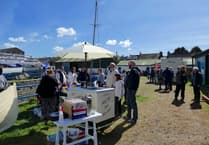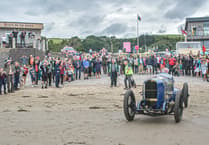Crowds of visitors and motoring enthusiasts celebrated an historic motoring anniversary in Pendine, as the National Motor Museum took the iconic Sunbeam 350hp vehicle back to the sands of the Carmarthenshire beach to celebrate the centenary anniversary of its World Land Speed Record in 1925.
The historic event was celebrated with a roaring engine start-up followed a thrilling, evocative drive along part of the expansive beach. Threatening rain clouds evaded; the streamlined vehicle looked magnificent along the Carmarthenshire coastline.
The car christened ‘Blue Bird’ by its celebrated daring driver Sir Malcolm Campbell MBE, was the first to exceed 150 mph (240 km/h). The World Land Speed Record of 150.766 mph (242.628 km/h) was set at the Welsh beach on the 21 July 1925. Now part of the vehicle collection at the National Motor Museum at Beaulieu, the Museum is celebrating this feat of British engineering and the centenary of the historic event.
Don Wales, the grandson of Malcolm Campbell and supporter of the National Motor Museum’s car restoration efforts was also pictured in the Sunbeam’s driving seat, and later joined by Lord Montagu of Beaulieu, President of the National Motor Museum, alongside the car. Other classic cars contemporary with the Sunbeam joined the vehicle on the beach, including the Bentley once owned by Malcolm Campbell’s son Donald Campbell.
The Museum’s Senior Engineer, Ian Stanfield, chiefly responsible for the Sunbeam’s restoration had the privilege of taking the car ‘for a spin’ once part of the beach was safely cleared for the demonstration run. The Sunbeam was then on display outside the Museum of Land Speed at Pendine for the remainder of the day.
National Motor Museum Trust Chief Executive Jon Murden said: “We are delighted to have been able to honour such a landmark World Land Speed Record anniversary with this and other events this year, which will both celebrate its importance in motoring history and provide more opportunities to see Blue Bird.”
Speaking at Pendine, Doug Hill, the National Motor Museum’s Chief Engineer and Museum Manager said: “The Sunbeam 350hp is an 18.4 litre V12 semi aero engine monster. It was the fastest car in the world 100 years ago. Campbell was up and coming race driver and he realized that there was a lot of endeavour and glory to be had in being the fastest man on the planet, and so he bought the Sunbeam 350hp from the Sunbeam company.
“It had already won the land speed record at Brooklands, and so Malcolm thought, with his team of engineers, he could get the car to go faster. He therefore bought it, raced it, sprinted it, and used hill climbs, and then he took it to Pendine in September 1924 and took it to over 146 mph.
“He knew however that he could squeeze some more out of it. Big, courageous guy that he was, he did just that and on 21 July 1925 achieved the best run over the mile of 152.833 mph, and on average raised the World Land Speed Record to 150.766 mph, the first time a car had exceeded 150 mph.”
The Sunbeam 350hp was at the Heveningham Concours, the Bluebird Restaurant in Chelsea, and a Sunbeam Talbot Alpine Register gathering before its appearance in Pendine and has returned to Beaulieu where it is on permanent display with other Land Speed Record breakers Sunbeam 1000hp, Golden Arrow and the Bluebird CN7. The Museum is also home to an Icons of Formula 1 display this summer making it the venue to see brilliant examples of sporting and technical excellence in pursuit of the thrill of speed.
This isn’t the first time the Sunbeam 350hp has returned to Pendine. It visited the famous stretch of sands in 2015 following completion of the painstaking rebuild of the 1920 Sunbeam’s complex V12 engine enabling supporters to hear it roar again for the first time in over 50 years.
For the 2025 celebration a section on the National Motor Museum website is dedicated to the history on the Sunbeam 350hp - https://nationalmotormuseum.org.uk/sunbeam-350hp-blue-bird/
Specially commissioned limited edition commemorate merchandise is also available from the Museum providing opportunities to help the Museum fund similar vehicles restoration projects in the future as well as a future valuable collectable.





Comments
This article has no comments yet. Be the first to leave a comment.